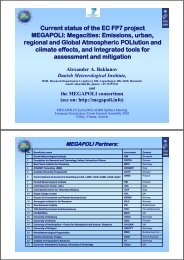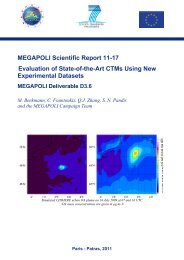D E S C R I P T I O N O F W O R K - MEGAPOLI - Dmi
D E S C R I P T I O N O F W O R K - MEGAPOLI - Dmi
D E S C R I P T I O N O F W O R K - MEGAPOLI - Dmi
Create successful ePaper yourself
Turn your PDF publications into a flip-book with our unique Google optimized e-Paper software.
<strong>MEGAPOLI</strong> 212520<br />
PART B<br />
B1 Concept and objectives, progress beyond state-of-the-art, scientific and<br />
technical methodology and work plan<br />
B.1.1 Concept and project objectives<br />
The main objectives of the <strong>MEGAPOLI</strong> project are:<br />
Objective 1: to assess impacts of megacities and large air-pollution “hot-spots” on local,<br />
regional, and global air quality and climate;<br />
Objective 2: to quantify feedbacks between megacity emissions, air quality, local and regional<br />
climate, and global climate change;<br />
Objective 3: to develop and implement improved, integrated tools to assess the impacts of air<br />
pollution from megacities on regional and global air quality and climate and to evaluate the<br />
effectiveness of mitigation option<br />
<strong>MEGAPOLI</strong> will include both basic and applied research, and will bridge the spatial and temporal<br />
scales that connect local emissions, air quality and weather conditions with global atmospheric<br />
chemistry and climate.<br />
In order to fulfil the objectives the following scientific questions will be addressed:<br />
Q1: What is the change of exposure of the overall population to the major air pollutants as<br />
people move into megacities? What are the health impacts of this exposure? (Objective 1)<br />
Q2: How do megacities affect air quality on regional and global scales? What is the range of<br />
influence for major air pollutants (ozone, particulate matter, etc.)? (Objective 1)<br />
Q3: What are the major physical and chemical transformations of air pollutants as they are<br />
moving away from megacities? What happens to the organic particulate matter, volatile organic<br />
compounds, etc? (Objective 1)<br />
Q4: How accurate are the current emission inventories for megacities in Europe and around the<br />
world? What are the major gaps? (Objective 1)<br />
Q5: How large is the current impact of megacities on regional and global climate? (Objective 2)<br />
Q6: How will the growth of megacities affect future climate at global and regional scales?<br />
(Objective 2)<br />
Q7: What is the impact of large-scale dynamic processes on air pollution from megacities?<br />
(Objective 2)<br />
Q8: What are the key feedbacks between air quality, local climate and global climate change<br />
relevant to megacities? For example, how will climate change affect air quality in megacities?<br />
(Objective 2)<br />
Q9: How should megacities (emissions, processing inside megacities, meteorology) be<br />
parameterised in regional and global models? (Objective 3)<br />
Q10: What type of modelling tools should be used for the simulation of multi-scale megacity air<br />
quality - climate interactions? (Objective 3)<br />
Q11: Which policy options are available to influence the emissions of air pollutants and<br />
greenhouse gases in megacities and how can these options be assessed? (Objective 3)<br />
In order to answer the above questions and achieve the main objectives we will perform the<br />
following tasks:<br />
T1: Develop and evaluate integrated methodologies to improve emission data from<br />
megacities on regional through global scales; (Objective 1)<br />
7




